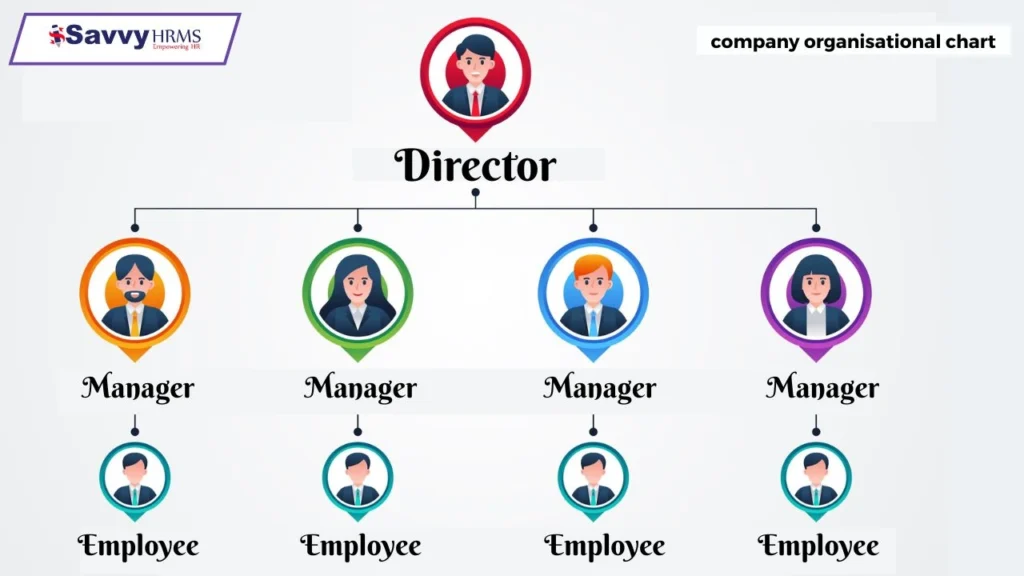Doesn’t it excite you how companies remain organized & efficient with hundreds of employees? In this fast-paced work environment. Clarity on who is doing what becomes very important. Let’s understand the company organizational chart. Why are they important, and the influence do they possess on your professional life?
Company Organisational Chart Defined
It is a presentation of a company’s structure. Marking out the levels of management from top executive to junior employee.
Furthermore, it shows:
- Different Departments
- Reporting Lines
- Levels of Authority
- Relations Between Teams
These days, many companies leverage modern HR management systems. To prepare and maintain these charts.
What Goes into a Company Organizational Chart?
Now, let’s take a moment to further define what goes into creating a good organizational chart:
- Levels in the Hierarchy
First, it represents the hierarchy from the CEO to team members clearly.
This means employees can know whom they report to.
- Departmental Divisions
Next, the departments segregate within themselves: Marketing, Finance, Sales, and HR.
- Roles
Then, it details the title and key responsibilities associated with each position.
- Reporting Relationships
Finally, it represents direct reporting lines and team structures.
That is when communication is better structured.
Today, most companies manage these elements efficiently through advanced performance management systems.
Why is a company’s Organisational Chart Important?
Having a clear structure helps in several ways:
- Clear flow of communication
- Faster decision-making
- Better accountability for employees
- Smooth onboarding process
- Improved workforce planning
Thus, it is quite helpful for managers as well as employees to know the chart.
Types of Company Organisational Chart
Interestingly, companies do not follow a single organizational chart.
Different structures apply depending on size and goals:
- Hierarchical Chart
This is the model most commonly used.
- Flat Structure
It is often used by startup firms, encouraging openness and quick decision-making.
- Matrix Structure
This structure works best in project-oriented companies.
In the current day, many companies use the organizational development strategy. To design different types of structures.
Steps to Create a Company Organizational Chart
Here are simple actions to take if you are making an org chart:
- Gather all job titles
- Define lines of reporting
- Group them into departments
- Choose an org chart format (hierarchical, flat, or matrix)
Use human resources software for easy updates and continued maintenance of the chart. Even after promotions, hiring, or restructuring.
What’s HR Tech Doing With the Company Organisational Charts?
It is now much easier to manage organisational charts thanks to technology.
Modern HR tools can now:
- Auto-update charts after promotions or new hires
- Integrate an employee profile with charts
- Facilitate succession planning
- Stimulate inter-team collaboration
Thus, smart companies use an HR management system. To make charts more dynamic & accurate.
Company Organizational Charts and Succession Planning
Company Organisational charts are also a huge aid to succession planning.
Clarity about the present structure will enable the HR teams. To identify potential future leaders. Facilitate the creation of internal talent pipelines. Bridge skill gaps to reduce reliance on external recruitment.
Common Mistakes to Avoid When Working with Organisational Charts
While creating or updating a chart, keep the following common mistakes in mind:
- Complicating matters
- Forgetting to update when changes are made
- Missing out on interdepartmental connections
- Not representing the way the business really works
If you are able to steer clear of these mistakes. Your company’s organisational chart would stay relevant as a working tool. Rather than merely being ceremonial.
Conclusion
Company organisational charts are visual tools that maintain charm and order. Promote communication, and clearly define responsibility. These days, companies are smartly incorporating it. With other HR management systems, performance management systems. Organisational development and human resources computer-based solutions.
Beyond that, a good organisational structure has the goodness of enhancing productivity. Via strengthening collaboration towards firm growth. It’s high time that a really good chart is still missing in your organisation!
FAQs
Q1. What is the function of a Company Organizational Chart?
It lays out the structure of a company, specifying roles, responsibilities & reporting relationships.
Q2. Which industries use organisational charts?
Almost all industries, be it IT, healthcare, manufacturing, or education. Are you using organisational charts for effective internal communication?
Q3. How often should a company update its organisational chart?
As a rule of thumb, after every single major change. Promotion, hiring, layoff, or organizational restructuring.
Q4. Can organisational charts be used in startups?
Absolutely! Actually, most startups use flat organisational charts. Because they are easier to be flexible and accountable in Hr Software.



